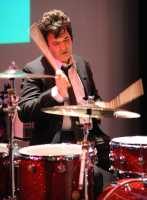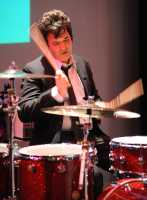Author Interviews, Autism, Education, Exercise - Fitness, Pediatrics / 26.09.2018
Children with Emotional and Behavioral Issues May Benefit From Drumming Lessons
MedicalResearch.com Interview with:
 Dr. Marcus Smith PhD
Reader in Sport and Exercise Physiology
University of Chichester
Co-founder, Clem Burke Drumming Project
MedicalResearch.com: What is the background for this study?
Response: The research group first started to examine rock drumming from a scientific perspective in 1999 through collaboration with Clem Burke, drummer with the iconic band ‘Blondie’. In 2008 the Clem Burke Drumming Project (CBDP) was formed (visit clemburkedrummingproject.org for further information) where academics from different disciplines came together to not only explore the physiological demands of rock drumming but also the potential use of rock drumming as an intervention in research studies. Rock drumming is attractive to the scientist in that it is a unique activity that requires the coordination of multiple limbs to produce the required drumming pattern. Inherent demands relating to timing, tempo and volume must also be met. Therefore, the ability to manipulate these facets of drumming performance in a research setting is very appealing. In relation to potential research populations drumming has a universal fascination regardless of age, gender, culture, language competency and ethnicity. Anecdotal evidence suggests that drumming is a ‘cool’ activity that has a unique ‘language currency’ in terms of stimulating communication within and between those who can and cannot play the drums.
The impetus for our research study came from parents of autistic children contacting us to express their belief that drumming was having a positive effect on their child’s physical and psychological behaviour. A review of the literature showed a range of anecdotal evidence in support of such statements (Freidman 2000) and an increase in empirical drumming based research being undertaken (Bungay 2010). More recent studies have reported psychosocial benefits such as enhanced communication (Maschi et al. 2010; 2012), emotional processing and tension reduction (Flores et al. 2016; Maschi et al. 2010; 2012), group cohesion and connectedness (Blackett et al. 2005), concentration, psychomotor coordination and posture (Chen et al. 2017). The majority of this work was undertaken with adolescents with very little work focused on younger age groups. (more…)
Dr. Marcus Smith PhD
Reader in Sport and Exercise Physiology
University of Chichester
Co-founder, Clem Burke Drumming Project
MedicalResearch.com: What is the background for this study?
Response: The research group first started to examine rock drumming from a scientific perspective in 1999 through collaboration with Clem Burke, drummer with the iconic band ‘Blondie’. In 2008 the Clem Burke Drumming Project (CBDP) was formed (visit clemburkedrummingproject.org for further information) where academics from different disciplines came together to not only explore the physiological demands of rock drumming but also the potential use of rock drumming as an intervention in research studies. Rock drumming is attractive to the scientist in that it is a unique activity that requires the coordination of multiple limbs to produce the required drumming pattern. Inherent demands relating to timing, tempo and volume must also be met. Therefore, the ability to manipulate these facets of drumming performance in a research setting is very appealing. In relation to potential research populations drumming has a universal fascination regardless of age, gender, culture, language competency and ethnicity. Anecdotal evidence suggests that drumming is a ‘cool’ activity that has a unique ‘language currency’ in terms of stimulating communication within and between those who can and cannot play the drums.
The impetus for our research study came from parents of autistic children contacting us to express their belief that drumming was having a positive effect on their child’s physical and psychological behaviour. A review of the literature showed a range of anecdotal evidence in support of such statements (Freidman 2000) and an increase in empirical drumming based research being undertaken (Bungay 2010). More recent studies have reported psychosocial benefits such as enhanced communication (Maschi et al. 2010; 2012), emotional processing and tension reduction (Flores et al. 2016; Maschi et al. 2010; 2012), group cohesion and connectedness (Blackett et al. 2005), concentration, psychomotor coordination and posture (Chen et al. 2017). The majority of this work was undertaken with adolescents with very little work focused on younger age groups. (more…)
 Dr. Marcus Smith PhD
Reader in Sport and Exercise Physiology
University of Chichester
Co-founder, Clem Burke Drumming Project
MedicalResearch.com: What is the background for this study?
Response: The research group first started to examine rock drumming from a scientific perspective in 1999 through collaboration with Clem Burke, drummer with the iconic band ‘Blondie’. In 2008 the Clem Burke Drumming Project (CBDP) was formed (visit clemburkedrummingproject.org for further information) where academics from different disciplines came together to not only explore the physiological demands of rock drumming but also the potential use of rock drumming as an intervention in research studies. Rock drumming is attractive to the scientist in that it is a unique activity that requires the coordination of multiple limbs to produce the required drumming pattern. Inherent demands relating to timing, tempo and volume must also be met. Therefore, the ability to manipulate these facets of drumming performance in a research setting is very appealing. In relation to potential research populations drumming has a universal fascination regardless of age, gender, culture, language competency and ethnicity. Anecdotal evidence suggests that drumming is a ‘cool’ activity that has a unique ‘language currency’ in terms of stimulating communication within and between those who can and cannot play the drums.
The impetus for our research study came from parents of autistic children contacting us to express their belief that drumming was having a positive effect on their child’s physical and psychological behaviour. A review of the literature showed a range of anecdotal evidence in support of such statements (Freidman 2000) and an increase in empirical drumming based research being undertaken (Bungay 2010). More recent studies have reported psychosocial benefits such as enhanced communication (Maschi et al. 2010; 2012), emotional processing and tension reduction (Flores et al. 2016; Maschi et al. 2010; 2012), group cohesion and connectedness (Blackett et al. 2005), concentration, psychomotor coordination and posture (Chen et al. 2017). The majority of this work was undertaken with adolescents with very little work focused on younger age groups. (more…)
Dr. Marcus Smith PhD
Reader in Sport and Exercise Physiology
University of Chichester
Co-founder, Clem Burke Drumming Project
MedicalResearch.com: What is the background for this study?
Response: The research group first started to examine rock drumming from a scientific perspective in 1999 through collaboration with Clem Burke, drummer with the iconic band ‘Blondie’. In 2008 the Clem Burke Drumming Project (CBDP) was formed (visit clemburkedrummingproject.org for further information) where academics from different disciplines came together to not only explore the physiological demands of rock drumming but also the potential use of rock drumming as an intervention in research studies. Rock drumming is attractive to the scientist in that it is a unique activity that requires the coordination of multiple limbs to produce the required drumming pattern. Inherent demands relating to timing, tempo and volume must also be met. Therefore, the ability to manipulate these facets of drumming performance in a research setting is very appealing. In relation to potential research populations drumming has a universal fascination regardless of age, gender, culture, language competency and ethnicity. Anecdotal evidence suggests that drumming is a ‘cool’ activity that has a unique ‘language currency’ in terms of stimulating communication within and between those who can and cannot play the drums.
The impetus for our research study came from parents of autistic children contacting us to express their belief that drumming was having a positive effect on their child’s physical and psychological behaviour. A review of the literature showed a range of anecdotal evidence in support of such statements (Freidman 2000) and an increase in empirical drumming based research being undertaken (Bungay 2010). More recent studies have reported psychosocial benefits such as enhanced communication (Maschi et al. 2010; 2012), emotional processing and tension reduction (Flores et al. 2016; Maschi et al. 2010; 2012), group cohesion and connectedness (Blackett et al. 2005), concentration, psychomotor coordination and posture (Chen et al. 2017). The majority of this work was undertaken with adolescents with very little work focused on younger age groups. (more…)
